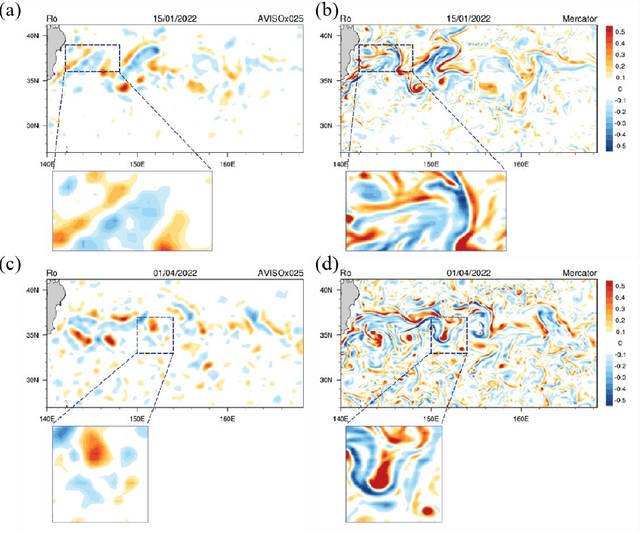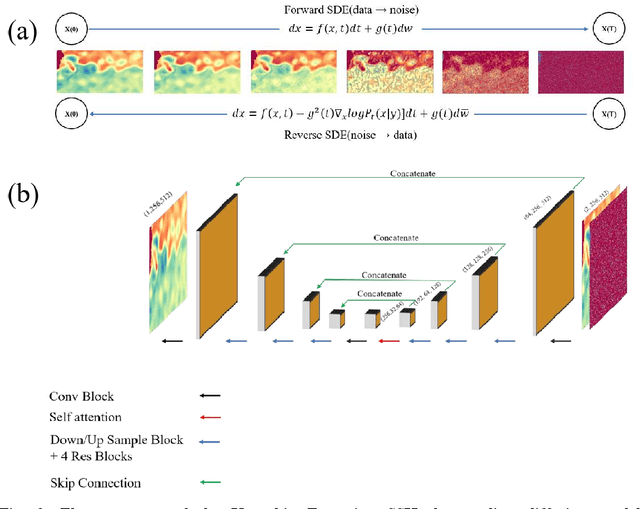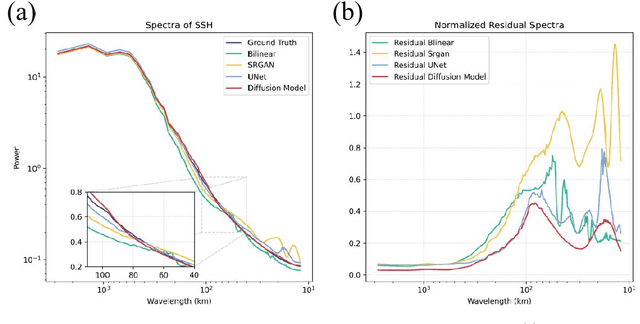Renhe Zhang
DaYu: Data-Driven Model for Geostationary Satellite Observed Cloud Images Forecasting
Nov 15, 2024Abstract:In the past few years, Artificial Intelligence (AI)-based weather forecasting methods have widely demonstrated strong competitiveness among the weather forecasting systems. However, these methods are insufficient for high-spatial-resolution short-term nowcasting within 6 hours, which is crucial for warning short-duration, mesoscale and small-scale weather events. Geostationary satellite remote sensing provides detailed, high spatio-temporal and all-day observations, which can address the above limitations of existing methods. Therefore, this paper proposed an advanced data-driven thermal infrared cloud images forecasting model, "DaYu." Unlike existing data-driven weather forecasting models, DaYu is specifically designed for geostationary satellite observations, with a temporal resolution of 0.5 hours and a spatial resolution of ${0.05}^\circ$ $\times$ ${0.05}^\circ$. DaYu is based on a large-scale transformer architecture, which enables it to capture fine-grained cloud structures and learn fast-changing spatio-temporal evolution features effectively. Moreover, its attention mechanism design achieves a balance in computational complexity, making it practical for applications. DaYu not only achieves accurate forecasts up to 3 hours with a correlation coefficient higher than 0.9, 6 hours higher than 0.8, and 12 hours higher than 0.7, but also detects short-duration, mesoscale, and small-scale weather events with enhanced detail, effectively addressing the shortcomings of existing methods in providing detailed short-term nowcasting within 6 hours. Furthermore, DaYu has significant potential in short-term climate disaster prevention and mitigation.
Generative Diffusion Model-based Downscaling of Observed Sea Surface Height over Kuroshio Extension since 2000
Aug 22, 2024



Abstract:Satellite altimetry has been widely utilized to monitor global sea surface dynamics, enabling investigation of upper ocean variability from basin-scale to localized eddy ranges. However, the sparse spatial resolution of observational altimetry limits our understanding of oceanic submesoscale variability, prevalent at horizontal scales below 0.25o resolution. Here, we introduce a state-of-the-art generative diffusion model to train high-resolution sea surface height (SSH) reanalysis data and demonstrate its advantage in observational SSH downscaling over the eddy-rich Kuroshio Extension region. The diffusion-based model effectively downscales raw satellite-interpolated data from 0.25o resolution to 1/16o, corresponding to approximately 12-km wavelength. This model outperforms other high-resolution reanalysis datasets and neural network-based methods. Also, it successfully reproduces the spatial patterns and power spectra of satellite along-track observations. Our diffusion-based results indicate that eddy kinetic energy at horizontal scales less than 250 km has intensified significantly since 2004 in the Kuroshio Extension region. These findings underscore the great potential of deep learning in reconstructing satellite altimetry and enhancing our understanding of ocean dynamics at eddy scales.
Quantitative causality, causality-guided scientific discovery, and causal machine learning
Feb 20, 2024Abstract:It has been said, arguably, that causality analysis should pave a promising way to interpretable deep learning and generalization. Incorporation of causality into artificial intelligence (AI) algorithms, however, is challenged with its vagueness, non-quantitiveness, computational inefficiency, etc. During the past 18 years, these challenges have been essentially resolved, with the establishment of a rigorous formalism of causality analysis initially motivated from atmospheric predictability. This not only opens a new field in the atmosphere-ocean science, namely, information flow, but also has led to scientific discoveries in other disciplines, such as quantum mechanics, neuroscience, financial economics, etc., through various applications. This note provides a brief review of the decade-long effort, including a list of major theoretical results, a sketch of the causal deep learning framework, and some representative real-world applications in geoscience pertaining to this journal, such as those on the anthropogenic cause of global warming, the decadal prediction of El Ni\~no Modoki, the forecasting of an extreme drought in China, among others.
 Add to Chrome
Add to Chrome Add to Firefox
Add to Firefox Add to Edge
Add to Edge